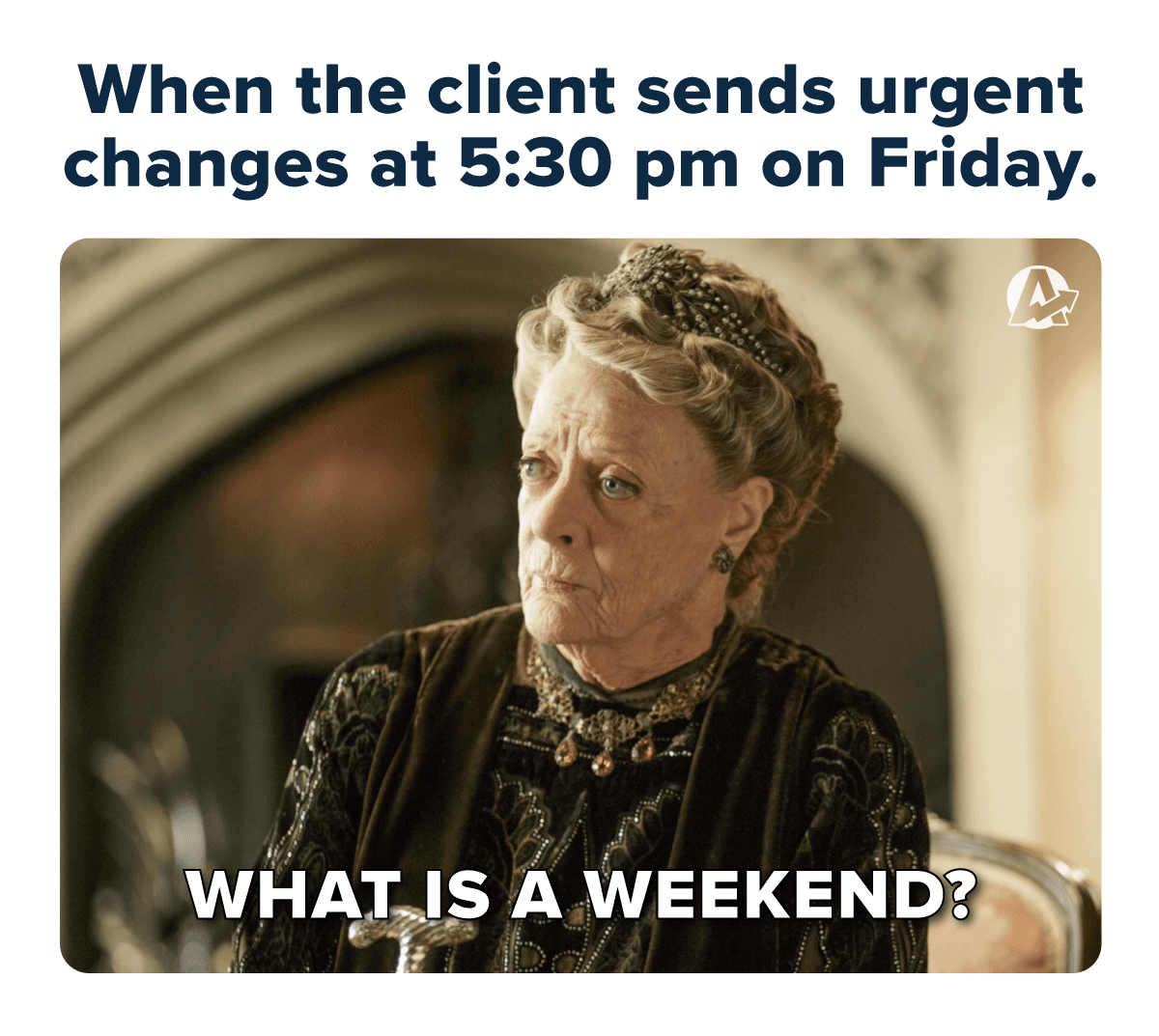Table of Contents
QUICK SUMMARY:
Scope creep is a common challenge in project management, referring to the gradual expansion of a project's scope after its initiation. This guide provides marketing agencies with effective strategies to manage and prevent scope creep, ensuring projects remain within original parameters and budgets. Learn to maintain control over project trajectories and safeguard against unplanned expansions and costs.
The agency hustle. A frenetic dance that project managers and account managers know all too well. Picture a bustling marketing agency where the air hums with the sounds of strategy crafting, content creation, and campaign execution. Visualize the glorious cycle of client briefs transforming into successful marketing campaigns. Everything is smooth sailing, right? If only. The tale wouldn't be complete without the infamous villain–Scope Creep.
Any project manager at a marketing agency understands the scenario. A well-defined project, clear deliverables, timelines are set, and then comes the slow but steady scope creep.
Scope creep, a term that sets the alarm bells ringing, is the painful process where extra tasks–beyond the initial scope–creep into the project (hence the name). The tasks multiply, timelines stretch, and suddenly, managing the project feels like navigating through a maze with no exit.

Dealing with scope creep isn't optional for a project manager at a marketing agency. It's a critical skill. It's about maintaining control, managing project stakeholders effectively, and ensuring the original project plan doesn't spiral into a quagmire of add-ons and 'just one more thing' tasks.
But how does one manage scope creep? More importantly, how does one overcome scope creep? The task may seem daunting, akin to holding back the tide. But it's not an insurmountable challenge.
This guide will take you through a systematic approach to handling project scope creep.
It's not about quick fixes or hacks; it's about implementing robust measures to keep your projects on track. As we journey through the following sections, you'll gain a deeper understanding of how to tackle and overcome the often tricky challenge of scope creep. And soon, you'll view each project with renewed confidence, ready to take on whatever comes your way.
Why Your Agency Needs to Overcome Scope Creep
Do you ever look back at an original project proposal wondering what the heck happened?
Your agency started with a clear plan, set expectations after a successful discovery call, and a delivery roadmap. But all of sudden, your team is putting in more effort than even your biggest accounts. And that’s without getting paid an extra dime.
It can be tempting to simply bow to every demand, no matter how unreasonable it may be, just for the sake of keeping a client happy. However, this could lead to an unhealthy work environment for you and/or your employees—not to mention lost revenue. Striking that delicate balance between retaining clients while also protecting your business's values is often tricky but essential to success.
Michael Quinn, Founder of My Site Ranked
Unfortunately, that’s what can happen when scope creep enters the picture and is left to its own devices. Suddenly, a well-planned project begins to include tasks and responsibilities your agency would typically charge big money for–and you’re afraid to say anything for fear that you might lose the client… while losing the money instead.
Understanding Scope Creep
To avoid scope creep, we first need to understand it. So, let's dive in and unravel the mystery behind scope creep.
Unraveling the Causes of Scope Creep
Scope creep occurs when there are additions or changes to a project's scope after the project has started, without adjustments to time, cost, or resources. It's like deciding to add an extra floor to your house while it's being built but not extending the completion date or budget. Sounds tricky, right? Here are a few primary causes:
Unclear Project Scope: If the project's objectives, deliverables, and key stakeholders' expectations aren't clearly defined at the outset, it leaves room for ambiguity and additions as the project progresses.
Poor Communication: Ineffective communication between the project team, client, and other stakeholders can lead to misunderstandings about what the project deliverables should be.
Lack of Change Control Process: Without a defined process for managing changes to the project, it's easy for additional tasks to creep into the project, disrupting the original plan.
Examining the Impact on Project Outcomes
When scope creep takes hold, it's not just about a few extra tasks for the project team. It can have a far-reaching impact on the project outcomes.
Delayed Deliverables: Additional tasks mean additional time. Scope creep can push out the project schedule, leading to delayed deliverables.
Reduced Quality: When the project team is stretched thin managing added tasks, the quality of deliverables can suffer.
Team Burnout: Constantly shifting goals and increased workload can lead to stress and burnout within the project team.

Assessing the Effect on Agency Profitability
Preventing scope creep isn't just about ensuring a smooth project journey. It has a direct impact on the agency's bottom line.
Increased Costs: Extra tasks without additional budget can increase the project's costs. This could mean overtime, extra resources, or increased operational costs.
Reduced Agency Profit Margins: When you're spending more time, resources, and energy than initially budgeted, the project's profitability decreases.
Client Dissatisfaction: Scope creep can lead to missed deadlines and compromised quality. Dissatisfied clients may choose not to work with the agency again, impacting future revenue.
Understanding scope creep, its causes, and its impact is the first step to preventing scope creep. With this knowledge, project managers can anticipate when scope creep may occur and take steps to manage it effectively.
5 Steps To Stop Scope Creep In Its Tracks
Scope creep–also known as project creep–is a common part of agency life, where the scope of a project gradually expands beyond its original parameters. This results in delays, budget overruns, and decreased overall quality of work and morale.
Let’s discuss five actionable steps to eliminate the chances of unwanted scope creep before things go haywire.
#1. Make a Deal, Shake on It: Setting Upfront Terms and Conditions With Your Client
If your agency has done a particular type of project a million times, it can be tempting to skip defining terms and conditions in an agency contract to speed things up. However, it’s an important step to protect your agency, create boundaries, and save time during client onboarding.
Let’s say you’ve onboarded a new client for SEO services based on an amazing SEO proposal but without a contract. After all, it’s not your first rodeo. A few weeks go by, and your client’s search ranking is steadily climbing (but not in the top three of SERP results–yet). And it’s no secret (to you, at least): SEO takes time to generate results.
To prove your worth and keep up with ongoing algorithm changes, you’ve put in extra hours to do additional keyword research. Despite your best efforts, your client isn’t happy and threatens to jump ship after just a few weeks!
It takes time to build domain authority and gain improved rankings, so a long-term contract can help them get to where they want to be at that time. The disadvantages are that this is, of course, a substantial investment for the client, so not everyone can afford long-term SEO.
Joe Gilbert, Managing Director of Red Giraffe
Without a minimum contract period to protect your agency from premature churn, your SEO efforts are wasted, and your team is forced to put more effort into meeting unrealistic expectations.
As Joshua Kimmes, Owner of Bear North Digital, shares, “Having the time to show the impact of SEO is really important. Depending on the client, that can take anywhere from 6-12 months, so having the time to build that allows the agency to show ROI.”

Eliminate doubts by showing your clients exactly how their SEO efforts are progressing. Use a live, visual dashboard at your next 1:1 meeting–try it on AgencyAnalytics, free for 14 days.
What’s the lesson here? Set pre-defined terms and conditions upfront. This will overcome scope creep by:
Formalizing business relationships with your clients
Giving your agency adequate time to generate results (which is especially crucial for long-term strategies)
Having clearly defined responsibilities to reduce ambiguities about project scopes
#2. Change Happens: Build a Formal Process to Manage it
As an agency, you know all too well that project scopes shift and things change. It’s just the nature of the game. And sometimes, it’s inevitable! It’s important how you stay ahead of scope creep: you either avoid it altogether with practical measures or take advantage of it by turning it into an opportunity to upsell.
Let’s suppose a client decides to adjust their sails because of external factors (like a recession, the launch of new AI tools, or a Google algorithm update). And in spite of your terms of service, you’ll want to remain adaptable and adjust to new requirements.
Being a ‘yes’ agency, you agree–but not before introducing a change management process that formalizes the scope of the new project that:
Enforces your agency’s boundaries. Having this agency process in place signals that you’ll stick to a pre-defined scope of work unless a change is absolutely necessary
Outlines the process for timeline adjustments and budget reviews, which gives your agency enough time to recalibrate
Encourages your clients to be more conscious about revisions, especially since time and money are at stake
Prevents your agency from overextending and overdelivering. After all, burnout does no one favors!
To get started, your agency’s change management process should (at minimum) include the following processes:
Reviewing the requested changes. This will help your agency determine whether a change or addition is necessary to meet your client’s objectives.
Quoting and sending follow-up discussions. Even if your clients’ requests are minimal, your billable time matters. Before implementing any changes, have an open conversation about budget requirements.
Deciding on a deadline for amending or changing specific stages of the project. This is especially important for large-scale, intricate projects. You don’t want to scrap completed work at an earlier stage because of an abrupt scope change.
Client sign-off on the new timeline and budget. Before proceeding, formalize the change management by ensuring clients sign the dotted line. That way, everyone is clear about expectations.
#3. Get Your Act Together: Invest in a Project Management System for Agencies
To manage multiple project scopes at any given time, you’ll need the right infrastructure in place. Without it, you’ll lose track of deliverables and may even falter in delivering results.
Besides, relying on manual processes (such as copying and pasting screenshots for client reporting) isn’t sustainable in the long run.
Investing in the right project management tool will help your agency to:
Document project progress and all agency-client communication. This streamlined approach ensures that correspondence is accessible to both parties and helps your agency to identify any out-of-scope requests.

Keep communication transparent and housed in one place. No need to invest in multiple client reporting tools–try AgencyAnalytics by signing up for a free 14-day trial today!
Before AgencyAnalytics, our old client reporting process was a headache. We would spend hours gathering data from various sources, such as Google Analytics, social media platforms, and PPC campaigns. Then, we had to manually compile the information using screenshots, spreadsheets, and charts. The process was manual, error-prone, and not at all scalable. And don't even get us started on the stress levels at reporting time.
Adam Binder, Founder + CEO of Creative Click Media
Create a process for task management. By creating an ongoing task list, your employees will keep track of deliverables and client requests. That way, it’s much easier to identify additional billable work and take action before scope creep sets in.

Ensure that your staff knows their responsibilities and sticks to pre-defined project scopes. Create an ongoing task list on AgencyAnalytics–it’s free with a 14-day trial.
With a systematic approach to project management, you ensure that things go according to plan and don’t result in scope creep.
#4. No More Freebies: Build Quoting for Extra Work Into Your Agency’s Processes
If you’re doing extra work, your agency should be paid for it. Sounds obvious, doesn’t it?
Unless you include quoting and invoicing for any extra work in your agency’s processes, small changes will quickly add up. And guess what? When you’re juggling multiple project scopes, those unnoticed, unpaid oversights rack up huge costs. That means your agency may end up doing hundreds (or even thousands) of dollars worth of work… for free.
That’s exactly why your agency must have a system in place to send quotes and communicate with clients effectively.
Communication is key–be patient, and explain simply. Stick to your processes, and refer back to the scope of works and terms of service if need be. When a tricky client expects you to work within their time schedule without being mindful of the process, there can be tension. If you try to bend to their expectations, it will cost you time away from your existing client projects and will cause undue stress on your team.
Calum Maxwell, Managing Director of Optimise Online
Be sure to:
Create a pre-defined invoice template that’s easily customizable and accessible to your staff when needed.
Come up with agency pricing beforehand. For smaller, ad-hoc requests (e.g., creating social media graphics), consider a pre-sent hourly rate. On the other hand, more complex requests may require additional line items, and you may opt for project-based pricing. Use your pricing guide as a reference, but be sure to evaluate client requests on a case-by-case basis.
Train your staff to respond in an appropriate manner when billable requests come in. Instead of fulfilling requests right away, remind them to respond with, “Sure, let me send you a quote for that!”
Maintain boundaries when necessary. If your staff has determined that a request is out-of-scope and billable, respectfully but firmly communicate this to the client.
The biggest challenge in dealing with difficult client requests is reminding them that their request is "out of the scope of our agreement". But I will admit, this is my go-to response even though it's not an easy conversation.
Lisa Cutter, President of Vertical Insight Marketing
#5. Leveraging Clear Communication to Overcome Scope Creep
It's time to focus on one of the most powerful tools in your arsenal to prevent scope creep: clear and regular communication. Like a lighthouse guiding ships to safe harbor, effective communication can illuminate the project path, keep everyone on the same page, and steer your team clear of the jagged rocks of scope creep.
Communicating with Internal Teams
The success of a project heavily depends on the collaboration between project team members. Here's how clear communication within the team helps to prevent scope creep:
Understanding Project Objectives: Regular team meetings help everyone understand and align with the project goals and requirements. This shared understanding can help everyone stay focused on the original scope of work.
Managing Project Tasks: Routine discussions about task progress and project schedule allow teams to address issues promptly, mitigate potential risks, and keep the project on track.
Handling Change Requests: Having a process to communicate and assess change requests ensures any potential scope alterations are evaluated for their impact on the project timeline, budget, and entire project.
Sharing Project Updates with Key Stakeholders
Project stakeholders, such as clients and project sponsors, play a crucial role in project success. Keeping them in the loop can help prevent misunderstandings that could lead to scope creep.
Clarifying Project Goals: It's essential to reiterate and clarify the project goals to stakeholders continuously. This assures them that their interests are understood and aligned with the project objectives.
Updating Project Schedule: Regular updates on project progress and any changes in the schedule help manage stakeholder expectations. This open dialogue can mitigate scope creep by preemptively addressing concerns.
Discussing Change Impact: If there are change requests, clearly communicate the potential effects on the project timeline and budget. This can help stakeholders make informed decisions and understand the implications of changing the project scope.
Providing Ongoing Project Reports
Project reports provide an in-depth view of the project status and are a vital communication tool.
Visualizing Progress: Reports that visually represent progress against the project schedule help stakeholders see where the project stands and if scope creep threatens the project budget or timeline.
Flagging Scope Changes: Regular reporting can flag deviations from the original scope, allowing for timely discussions and decisions.
Detailing Change Requests: Reports should detail any change requests, their status, and their impact. This informs everyone of potential scope changes and provides a record for future reference.
Promoting Open Dialogue
While not a standalone subheading, promoting open dialogue is a thread that runs through all aspects of project communication. A culture that encourages questions, discussions, and feedback creates an environment where scope creep can be identified, discussed, and addressed before it impacts project success.
So, there you have it. With clear and regular communication, you're well-equipped to navigate through your projects, keeping scope creep at bay and sailing toward successful project delivery.
Stay On Target: Avoid Scope Creep and Maximize Efficiency
Wasting billable hours is any agency’s nightmare! And scope creep does just that. Remember to:
Set your terms and conditions beforehand
Develop a formal procedure for any additional client requests or project scope changes
Create a system for quoting and invoicing that’s easily replicable
Invest in the right infrastructure to manage your clients’ projects effectively
With time and money at stake, your agency can’t afford to slip up or miss client expectations. That’s where an automated reporting system like AgencyAnalytics comes in! Streamline communication, keep your staff accountable, and house your clients’ marketing metrics–all in one place.
AgencyAnalytics gives our clients clarity and confidence because of how easily we can communicate our efforts and results to them on a frequent, consistent basis. It allows us to report on all activities in one, cohesive, comprehensive, beautiful report instead of a bunch of disjointed pieces of information. This elevates our professionalism and is part of what allows us to charge the prices we know we're worth.
Lane Anderson, Founder & CEO, London Road Marketing
Monitor your clients’ deliverables and manage agency operations under one roof–try AgencyAnalytics today! It’s free for 14 days.

Written by
See how 7,000+ marketing agencies help clients win
Free 14-day trial. No credit card required.






